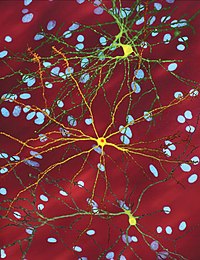
Photo from wikipedia
Huntington ’ s disease, a rare dominant degenerative disorder, manifests with neuropsychiatric changes and progres-sive cognitive and motor impairments. These diverse clinical manifestations re fl ect neurodegeneration initially in striatal… Click to show full abstract
Huntington ’ s disease, a rare dominant degenerative disorder, manifests with neuropsychiatric changes and progres-sive cognitive and motor impairments. These diverse clinical manifestations re fl ect neurodegeneration initially in striatal medium spiny neurons and progressing to involve the entire brain. Disease-causing expansions of a CAG/polyglutamine tract in the gene encoding huntingtin (HTT) protein trigger protein misfolding underlying the occurrence of histopatho-logically visible intranuclear and cytoplasmic inclusion bod-ies. As is likely for the eight other polyglutamine expansion disorders, proteotoxicity, as well as possibly RNA toxicity, underlies signi fi cant aspects of the pathogenic cascade, pro-viding the rationale for HTT-lowering therapeutics. Although HTT levels measured in cerebrospinal fl uid corre-late well with brain expression, visualization of mutant HTT in patients, particularly those entering trials of HTT-lowering therapeutics, would provide insight into the regional distribu-tion of pathology, assess target engagement, and permit in vivo evaluation of regional durability of therapeutic effects. detected pharmacological effects of two intervention para-digms: direct striatal delivery of adeno-associated virus (AAV)-expressing zinc- fi nger protein repressors of mutant HTT and genetic suppression of mutant HTT in a regulatable mouse model. Lowering of HTT in these models was associ-ated with positive effects on imaging markers of striatal neu-ron dysfunction.
Journal Title: Movement Disorders
Year Published: 2022
Link to full text (if available)
Share on Social Media: Sign Up to like & get
recommendations!